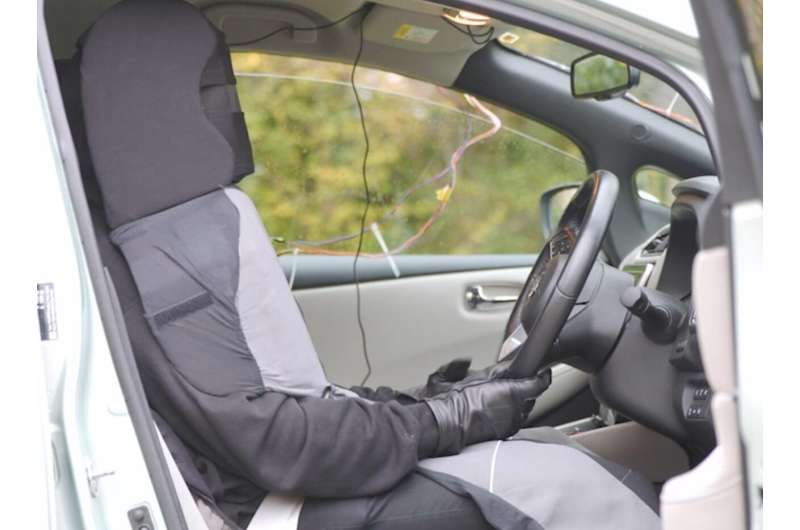This article has been reviewed according to Science X's editorial process and policies. Editors have highlighted the following attributes while ensuring the content's credibility:
fact-checked
trusted source
proofread
First ever UK 'ghost driver' study using visual displays to communicate with pedestrians

A novel study undertaken by the University of Nottingham has found that, in the absence of someone in the driving seat, pedestrians trust certain visual prompts more than others when deciding whether to cross in front of an autonomous car.
The aim of the study was to understand how pedestrians respond naturally to self-driving vehicles with different External Human-Machine Interfaces (eHMIs)—visual displays positioned on the front of the vehicle. To do this, a car was driven around the university's Park Campus over several days with a "ghost-driver" concealed in the driver's seat. A series of different designs projected onto the eHMI informed pedestrians of the car's behavior and intention—including expressive eyes and a face, accompanied by short text-based language such as "I have seen you" or "I am giving way."
The eHMI was controlled by a team member sat in the back seat, while front and rear dash cam footage was collected to observe pedestrians' reactions in real time. Additionally, researchers were placed at four crossing points to ask pedestrians to complete a short survey about their experience of the vehicle and its displays.
David R. Large, Senior Research Fellow with the Human Factors Research Group at the University of Nottingham, said, "As part of the ServCity project, which created a blueprint infrastructure for autonomous vehicles in the U.K., we wanted to explore how pedestrians would interact with a driverless car and developed this unique methodology to explore their reactions. We were keen to identify which designs invited the highest levels of trust by people wanting to cross the road."
"We used three different levels of anthropomorphism; implicit, an LED strip designed to mimic an eye's pupil, low, a vehicle centric icon and words such as 'giving way,' and explicit, an expressive face and human-like language," said David R. Large.
The study took place over several days, during which time 520 pedestrians interacted with the car, and 64 survey responses were collected. Several indicators from the dash cam footage were used to evaluate pedestrian's crossing behavior, including how long it took people to cross, how long they looked at the car and the number of times they glanced and/or gestured at the vehicle. This, combined with the survey results, gave researchers significant insights into people's attitudes and behavior in response to the different eHMI displays, and autonomous vehicles more generally.
"We were pleased to see that the external HMI, was deemed to be an important factor by a substantial number of respondents when deciding whether or not to cross the road—an encouraging discovery for furthering this type of work. With regard to the displays, the explicit eyes eHMI not only captured the most visual attention, but it also received good ratings for trust and clarity as well as the highest preference, whereas the implicit LED strip was rated as less clear and invited lower ratings of trust," said Professor Gary Burnett.
David said, "An interesting additional discovery was that pedestrians continued to use hand gestures, for example thanking the car, despite most survey respondents believing the car was genuinely driverless—showing that there is still an expectation of some kind of social element in these types of interaction."
Moving forward, the team will be looking to consider a broader range of vulnerable road users, such as cyclists and e-scooter users, and how they might naturally interact with a future autonomous vehicle. An additional recommendation is that studies also need to be undertaken over extended periods to understand how the public's response to a driverless car might change over time.
More information: Ghost Busting: A Novel On-Road Exploration of External HMIs for Autonomous Vehicles. www.researchgate.net/publicati … _Autonomous_Vehicles





















